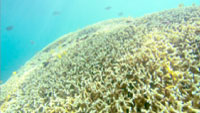 |
NASA | GSFC | JPL | Site Map |
|
|
 |
 |
Education: Student Outcomes |
Click here to search for other assets Water, Water Everywhere: Sun Fuels Evaporation Grade levels: K-4, 5-8, 9-12 Themes: ocean circulation, water cycle Video: water_everywhere_01.flv
Let's follow a single molecule of water, beginning in the ocean, through the paths it might take before eventually winding up right where it started - back in the big blue sea. The fuel for this journey will be provided by our planet's prime energy source: the sun. During the day, the sun heats up the air and ocean surface, causing water molecules to evaporate. Evaporation occurs when a liquid molecule of water escapes into the air as a gas. This scientific visualization shows how water evaporation, indicated in turquoise, is driven by the energy of the sun. Notice how the rate of evaporation pulses over land: it speeds up during the day and almost disappears at night. Over the ocean, evaporation appears to remain constant, both day and night. Water in the air in gas form is known as water vapor. The molecule is now fresh water, having left the ocean salt and other particles behind. (source) Student Outcomes After viewing this video, students should be able to: Describe the connections between the salt water found in the ocean and the fresh water in the water cycle. (O: K-4) Explain that evaporation can separate the water from the salt in salt water. (W: K-4) Explain the energy conversions found in the water cycle (e.g., evaporation requires heat energy, condensation releases heat energy). (W: 5-8) Explain how the processes of the water cycle (e.g., evaporation, precipitation) relate to the oceans. (W: 5-8) Explain the relationship between fresh water and ocean dynamics. (W: 9-12) Key: C = climate / O = ocean circulation / T = 21st century technology / W = water cycle |
|||||
